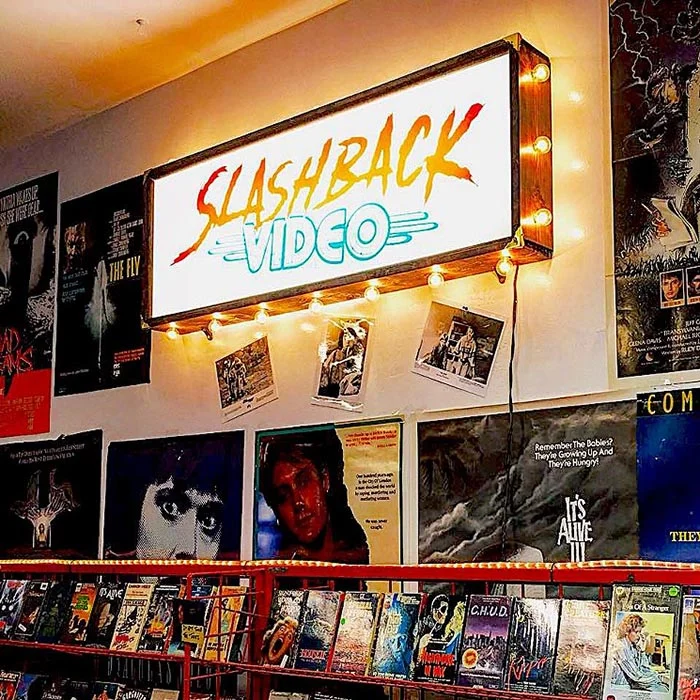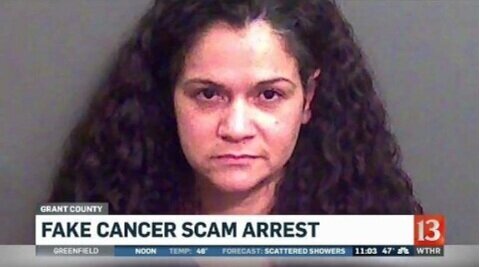A Retro Video Store That's Just Like the Real Thing
Classic horror films and the 1980s collide at a Los Angeles museum exhibit called “Revenge of Slashback Video.”
By Marybeth Connaughton
When it comes to authenticity, “Revenge of Slashback Video” has got the formula down pat. (Slashback Video)
I’m at “Revenge of Slashback Video,” a pop-up exhibit at the Bearded Lady’s Mystic Museum in Burbank, California, watching two elementary school-aged boys stare at an old Magnavox TV/VCR recorder. They’re looking at it the way I once stared at a butter churn on a school field trip to a pioneer house: with a mix of awe and relief at not having to grapple with such an exhausting device to produce something so essential to our everyday lives.
Technology has come a long way in the last 30 years and encountering the now-obsolete VHS tape feels akin to discovering a long-lost relic from the past. But for those old enough to remember what it was like to venture outside of the house to find their entertainment, "Revenge of Slashback Video” — which closes January 5th — can also feels hauntingly familiar.
The exhibition, a sequel to last year's wildly successful "Slashback Video," is a replica of a vintage video rental store from the late ‘80s/early ‘90s, recreated in painstaking detail, down to the Jiffy Pop and Crystal Pepsi on display at the mock checkout counter. Those looking to pore over the John Hughes canon or all 200 Police Academy movies, though, will need to look elsewhere. This exhibition, which costs $10, is in the best way, a horror show.
On nearly every inch of available space lies a nod to both era and genre. Freddy Krueger is an ubiquitous presence, his visage plastered around the faux store in the form of masks, busts, and promotional cutouts. The iconic skeleton-faced host from Tales From the Crypt is also heavily represented. The walls are covered with promotional posters for beloved horror movies and autographed headshots from B-list actors like Larry Zerner, who played Shelly in Friday the 13th Part III.
The most notable presence though, is the terrifyingly lifelike and life-sized model of Michael Myers. Not only did the jumpsuit-wearing serial killer serve as the prototype for all later slasher flick villains, but he’s sort of a mascot or point of pride for “Slashback Video.” (The exhibit’s co-creator, Ryan Turek, is a director for Blumhouse Productions, which just put out the latest Halloween sequel.)
This Michael Myers statue serves as a good reminder not to touch the tapes…or else. (Marybeth Connaughton)
Other more playful touches, like the sticker collages on the walls or the cut-out mouth on the Dead Alive poster that is cleverly placed atop the video return slot, feel wistfully familiar; the kind of accumulated personalization that made retro video stores destinations in and of themselves, and the starting point of many a teenage weekend.
Heidi, the thirty-something mother of the two boys I’d been watching earlier, can especially relate to this. “This was our Friday night, right here. You'd come to a video store with your friends, pick out your favorite snacks, and spend hours finding the perfect movie or two to take back home," she tells me.
Of course, patrons can’t actually rent the videos here; they’re just on display. In fact, you can’t even touch them at all. This precaution is largely practical (many of the videos are rare and out-of-print).
Also, without being able to flip the tapes over for summaries of the movies' plots, viewers can better appreciate the artwork and remember just how much could be portrayed in such a small rectangles of space.
Without a huge budget or the constraints of respectability, horror movie artwork often used invention to get attention. It had to scare viewers just enough without scaring them away.
"Whatever picture caught your eye as you were racing up and down the aisles — that was the movie you would pick," a balding dad in his 40s named Jose says.
Covers like He Knows You’re Alone — fingers curled in terror over a mouth and a wide pair of eyes transmitting a muffled scream — use minimalism to great effect. Others, like Wolfen, which features only a still shot of a gray-haired man staring quizzically at something offscreen, leave you with more questions than answers. The cover of SleepAway Camp III, featuring a young woman busting out of a skimpy top with the horrified expression of her next victim reflected in the huge knife she wields, may be the most succinct presentation of the horror genre's golden triad of sex, youth, and violence.
The horror trifecta of sex, youth, and violence is apparent in the artwork of this VHS tape. (MC)
The titles alone are entertaining. I notice tapes called I Dismember Mama and Stuff Stephanie in the Incinerator. Some of them serve as warnings, like Run...If You Can, Don’t Answer the Phone, and Don’t Fuck in the Woods. Others are so lacking in nuance they seem to have been run through Google translate (like Tales That Witness Madness).
In fact, the cover art and titles combined facilitate perhaps the most nostalgic element of the exhibit as a whole: the desire to engage in face-to-face conversations with the human beings around you.
Curious about a tape called The Evictors — which has a cowboy carrying a damsel past a dead tree on its cover — I go analog and ask the man next to me what he thinks the film might be about.
He doesn't venture to guess but warns me that Trilogy of Terror's cover art is highly misleading. If were to rent it in the real world, I’d apparently be very disappointed by the discrepancies in the art and plotline.
Across from us, another guy chimes in about which movies have the best new wave soundtracks. Couples stroll in holding hands, seeking refuge from the gloom of a Sunday afternoon, and reminisce about titles they watched before they knew each other. Friends in clusters move en masse, letting out squeals of recognition when they set eyes on movies they've long forgotten.
It all feels bittersweet, like a brief resurrection of an old way of life that you know you will never encounter again once you leave the phony vintage video store. Or maybe I’m wrong. As I exit the museum, I notice Heidi snapping pictures of the tapes with her iPhone. She tells her sons, “I’m texting these to your Dad so we can decide which movies we want to download next weekend.”











